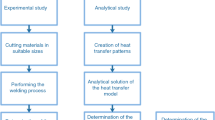Abstract
Recent computer calculations of heat transfer and fluid flow in welding were intended to provide useful insight about weldment geometry for certain specific welding conditions and alloys joined. However, no generally applicable correlation for the joining of all materials under various welding conditions was sought in previous work. To address this difficulty, computer models of fluid flow and heat transfer were used for the prediction of weld pool geometry in materials with diverse properties, such as gallium, pure aluminum, aluminum alloy 5182, pure iron, steel, titanium, and sodium nitrate under various welding conditions. From the results, a generally applicable relationship was developed between Peclet (Pe) and Marangoni (Ma) numbers. For a given material, Ma and Pe increased with the increase in laser power and decrease in beam radius. For materials with high Prandtl number (Pr), such as sodium nitrate, the Pe and Ma were high, and heat was transported primarily by convection within the weld pool. The resulting welds were shallow and wide. For low Pr number materials, like aluminum, the Pe and Ma were low in most cases, and low Pe made the weld pool deep and narrow. The cross-sectional areas of stationary and low speed welds could be correlated with welding conditions and material properties using dimensionless numbers proposed in this article.
Similar content being viewed by others
Abbreviations
- A :
-
cross-sectional area of the weld pool (m2)
- C ps :
-
specific heat of solid (J/kg K, which may also be written as m2/s2 K)
- C pl :
-
specific heat of liquid (J/kg K, which may also be written as m2/s2 K)
- D :
-
depth of the weld pool (m)
- DA:
-
dimensionless cross-sectional area
- DH:
-
dimensionless heat input
- dγ/dT :
-
temperature coefficient of the surface tension (N/m K, which may also be written as kg/s2 K)
- D s :
-
diameter of disc-shaped specimen (m)
- H f :
-
enthalpy of fusion (J/kg, which may also be written as m2/s2)
- H m :
-
enthalpy of liquid at melting point (J/kg, which may also be written as m2/s2)
- H s :
-
specimen thickness (m)
- K s :
-
thermal conductivity of solid (J/m s K, which may also be written as kg m/s3 K)
- K l :
-
thermal conductivity of liquid (J/m s K, which may also be written as kg m/s3 K)
- L s :
-
length of specimen (m)
- Ma:
-
Marangoni number
- Pe:
-
Peclet number
- Pr:
-
Prandtl number
- Q :
-
rate of heat absorption (J/s, which may also be expressed as kg/m2 s3)
- t :
-
irradiation time or the time necessary to reach quasi-steady-state size of the weld pool (s)
- T m :
-
melting point (K)
- V max :
-
calculated maximum surface velocity (m/s)
- W :
-
width of the weld pool (m)
- W s :
-
width of the specimen (m)
- α s :
-
thermal diffusivity of solid (m2/s)
- α l :
-
thermal diffusivity of liquid (m2/s)
- ΔT :
-
temperature drop from the center to the edge of the weld pool (K)
- μ :
-
viscosity (kg/m s)
- v :
-
kinematic viscosity (m2/s)
- ϱ :
-
density (kg/m3)
References
C.L. Chan, J. Mazumder, and M.M. Chen: Metall. Trans. A, 1984, vol. 15A, pp. 2175–84.
C.L. Chan, J. Mazumder, and M.M. Chen: Mater. Sci. Technol., 1987, vol. 3, pp. 306–11.
K. Mundra, T. DebRoy, and K.M. Kelkar: Num. Heat Transfer A, 1996, vol. 29, pp. 115–29.
S. Kou and D.K. Sun: Metall. Trans. A, 1985, vol. 16A, pp. 203–13.
T. Zacharia, S.A. David, J.M. Vitek, and T. DebRoy: Weld. J., 1989, vol. 68 (12), pp. 499–509.
S. Kou and Y.H. Wang: Metall. Trans. A, 1986, vol. 17A, pp. 2265–70.
C. Limmaneevichitr and S. Kou: Welding J., 2000, vol. 79 (8), pp. 231s-237s.
P.F. Mendez and T.W. Eager: in Trends in Welding Research, J.M. Vitek, S.A. David, J.A. Johnson, H.B. Smartt, and T. DebRoy, eds., ASM INTERNATIONAL, Materials Park, OH, 1998, pp. 13–18.
P.W. Fuerschbach: Welding J., 1996, vol. 75 (1), pp. 24s-34s.
P.W. Fuerschbach: in Trends in Welding Research, H.B. Smartt, J.A. Johnson, and S.A. David, eds., ASM INTERNATIONAL, Materials Park, OH, 1996, pp. 493–97.
H. Zhao and T. DebRoy: Metall. Mater. Trans. B, 2001, vol. 32B, pp. 163–72.
W. Pitscheneder, T. DebRoy, K. Mundra, and R. Ebner: Welding J., 1996, vol. 75 (3), pp. 71s-80s.
C. Limmaneevichitr and S. Kou: Welding J., 2000, vol. 79 (5), pp. 126s-135s.
E.A. Brandes: Smithells Metals Reference Book, 6th ed., in association with Fulmer Research Institute Ltd., Butterworth and Co., London, 1983.
E.J. Michaud, D.C. Weckman, and H.W. Kerr: Int. Congr. on Applications of Lasers and Electro-Optics (ICALEO ’94), Proc. Conf. on Laser Materials Processing, Oct. 17–20, 1994, Orlando, FL, T. Dwayne McCay, A. Matsunawa, and H. Hügel, eds., Laser Institute of America, Orlando, FL, 1994, pp. 461–70.
S. Basu and T. DebRoy: J. Appl. Phys., 1992, vol. 72 (8), pp. 3317–22.
Author information
Authors and Affiliations
Rights and permissions
About this article
Cite this article
Robert, A., Debroy, T. Geometry of laser spot welds from dimensionless numbers. Metall Mater Trans B 32, 941–947 (2001). https://doi.org/10.1007/s11663-001-0080-0
Received:
Issue Date:
DOI: https://doi.org/10.1007/s11663-001-0080-0




